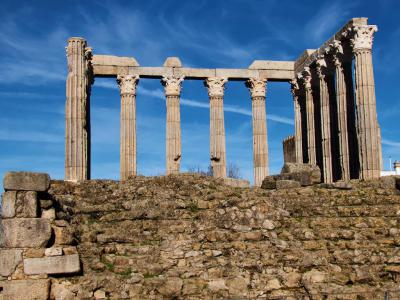
Templo Romano Evora (Roman Temple of Evora), Evora (must see)
The Roman Temple of Évora is a remarkable ancient structure. It holds significant historical and cultural value, representing a link between the Roman and Lusitanian civilizations that once thrived in the region. This temple is particularly notable for its connection to Augustus, the Roman emperor, as well as its place in the urban landscape of Évora.
Believed to have been constructed around the 1st century CE, the temple was dedicated to the veneration of Augustus, who was deified and worshipped as a god both during and after his reign. Its location within the main public square, formerly called Liberalitas Iulia, highlights its importance as a focal point of religious and administrative activities during the Roman era. As part of the city's transformation in the 2nd and 3rd centuries, the temple underwent modifications, reflecting the evolving religious and societal priorities of the time.
Tragically, the temple suffered destruction during the 5th century at the hands of invading Germanic groups, which marked the end of its original glory. However, even in its ruined state, the temple remains a testament to the architectural and cultural achievements of the past.
Positioned in the heart of Évora's central square, the temple holds a strategic location that once formed the highest point of the city's acropolis. It is surrounded by other historical and religious structures, including the Sé Cathedral, the Palace of the Inquisitor, the Palace of the Dukes of Cadaval, the Court of the Inquisition, the Church and Lóios' Convent, as well as the Public Library and Museum of Évora. This congregation of diverse buildings serves as a tangible representation of the city's rich history, showcasing various facets of its past.
Believed to have been constructed around the 1st century CE, the temple was dedicated to the veneration of Augustus, who was deified and worshipped as a god both during and after his reign. Its location within the main public square, formerly called Liberalitas Iulia, highlights its importance as a focal point of religious and administrative activities during the Roman era. As part of the city's transformation in the 2nd and 3rd centuries, the temple underwent modifications, reflecting the evolving religious and societal priorities of the time.
Tragically, the temple suffered destruction during the 5th century at the hands of invading Germanic groups, which marked the end of its original glory. However, even in its ruined state, the temple remains a testament to the architectural and cultural achievements of the past.
Positioned in the heart of Évora's central square, the temple holds a strategic location that once formed the highest point of the city's acropolis. It is surrounded by other historical and religious structures, including the Sé Cathedral, the Palace of the Inquisitor, the Palace of the Dukes of Cadaval, the Court of the Inquisition, the Church and Lóios' Convent, as well as the Public Library and Museum of Évora. This congregation of diverse buildings serves as a tangible representation of the city's rich history, showcasing various facets of its past.
Want to visit this sight? Check out these Self-Guided Walking Tours in Evora. Alternatively, you can download the mobile app "GPSmyCity: Walks in 1K+ Cities" from Apple App Store or Google Play Store. The app turns your mobile device to a personal tour guide and it works offline, so no data plan is needed when traveling abroad.
Templo Romano Evora (Roman Temple of Evora) on Map






Sight Name: Templo Romano Evora (Roman Temple of Evora)
Sight Location: Evora, Portugal (See walking tours in Evora)
Sight Type: Attraction/Landmark
Guide(s) Containing This Sight:
Sight Location: Evora, Portugal (See walking tours in Evora)
Sight Type: Attraction/Landmark
Guide(s) Containing This Sight:
Walking Tours in Evora, Portugal
Create Your Own Walk in Evora
Creating your own self-guided walk in Evora is easy and fun. Choose the city attractions that you want to see and a walk route map will be created just for you. You can even set your hotel as the start point of the walk.
Evora Introduction Walking Tour
Nestling in the sun-drenched Alentejo region of Portugal, Évora is a timeless gem in the heart of the country and one of its oldest and most enchanting cities.
The city's history spans over 5,000 years. The name Évora originates from the Celtic word "ebura," which means "of the yew trees."
The Romans conquered the place in 57 BC, shaping it into a vital town at... view more
Tour Duration: 2 Hour(s)
Travel Distance: 3.3 Km or 2.1 Miles
The city's history spans over 5,000 years. The name Évora originates from the Celtic word "ebura," which means "of the yew trees."
The Romans conquered the place in 57 BC, shaping it into a vital town at... view more
Tour Duration: 2 Hour(s)
Travel Distance: 3.3 Km or 2.1 Miles

